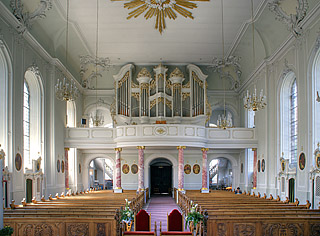Basilika church in Saarbrücken
The former organ of St. John the Baptist’s Basilika church in Saarbrücken was built by Messrs. Johannes Klais (Bonn) in 1975. About two thirds of the pipe section was new at the time, one third had been taken over from the preceding organ built in 1933. Two major aspects made for the organ concept in those days:
1. An organ framework adequate to the interior church design was to be created with the financial means available for the total renovation at the time. Owing to this request, the wonderful organ organ front was manufactured following the model of Stumm’s organ in St. Louis church in Saarbrücken.
2. The organ disposition of the registers followed the idea of Dr. Theo Klein, the Basilika organist at the time, who found his sound ideal in an organ of the Italian baroque era.
This extension of the registers towards romantic music for once takes into account the original Catholic idea of an appeal to all the senses. Romantic music and its soothing effect on the weary soul has been rediscovered as a "life elixir" in our technicalized world. The idea of contemplation, of music inspiring, strengthening and embellishing prayer only became possible through this harmonization of sound. The extension of the organ opened up the whole range of organ music, any kind of music of any era at all can be interpreted on that organ now. While the quality of the organ registers was very good, they only allowed an interpretation in proper style of baroque-era compositions. So the extension of the organ would fulfill not only musical and concert, but particularly lithurgical demands, too, especially under the aspect of the Basilika church as the central church of the area’s capital.
A matter of location
The existing organ was a unit completed in itself which was not to be modified. One option for the extension was adding separate small organ units above the altars of St. Mary Mother of God and St. Louis on the front balconies of the former prince boxes. The unique opportunity of organs on different levels in a church promised an extraordinary experience of sound. All organs may resound separately or together, controlled by one organist at the new main keyboard table. This way, "art replaced the prince", and art with its beautiful tunes now serves musica sacra.
Organ of St. Mary – French work
For this organ, we copied the registers of Aristide Cavaillé-Coll. The French organ builder, the "jeweller of Romanticism" was the greatest genius of his trade in his day. He built organs in almost all the big cathedrals around the world. One organ of his manufacture which is particularly famous because it has remained unchanged to this day is in the Catholic church of Notre-Dame in Metz/France, our French sister parish. We copied the romantic "heart", i.e. the swell of that organ, took over the corresponding scales of the pipe section, and the register intonation could be completed entirely following the romantic model. A project like that not only held aspects of sound, but also implied political and historical aspects and the demand to preserve traditional values, challenges that became all the more important as we are on our way into a united Europe. The organ front was designed according to the one at the main organ (identical harp sections, optical pipe scales following those of the big organ, etc.). The registers now present a separate mechanical organ with two manual keyboards and its own keyboard table. This opens wonderful new lithurgical options:
- workday masses, Lent and Advent masses may be accompanied on that smaller, but very diverse organ
- soloists may perform on the front balcony, so the audience can see them and they are no longer hidden in anonymity
- the whole repertory of music involving two organs (and a choir) may be performed
- all music involving organ and brass in exchange may be performed on both balconies
- the organ may serve accompanying purposes with other musical concerts, etc.
St. Louis organ – Spanish work
Around 1677, organ builders in Spain created the famous Spanish trumpets. These chamade registers had their heydin the 1750’s, just as the foundation stone was laid for our Basilika church. The famous registers owe their phantastic effect to their horizontal arrangement and an increased wind pressure. This organ can only be played from the main keyboard table of the main organ. As a whole, the creation of two symmetrical organ front enhanced the church’s interior architecture with its focus on the high altar, and ultimately also the unity of the high altar as a complete work of art.
The new keyboard table at the organ of St. Mary
The recit expressif of the organ in the church „Eglise Notre-Dame” in Metz served as an example. {gotop}







